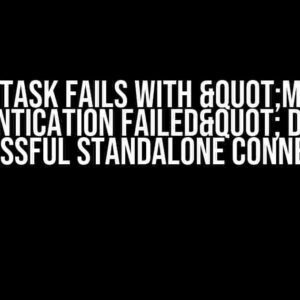Are you tired of waiting for what feels like an eternity for Amazon Redshift to complete its vacuum operation? You’re not alone! Many Redshift users have experienced this frustration, but fear not, dear reader, for we’re about to dive into the world of Redshift vacuuming and explore the reasons behind this sluggishness, as well as provide you with practical solutions to get your data warehouse humming again!
What is Vacuuming in Amazon Redshift?
In Amazon Redshift, vacuuming is an essential maintenance operation that reclaims space, reorganizes data, and updates statistics to improve query performance. It’s like a spring cleaning for your data warehouse!
There are two types of vacuuming in Redshift:
- Vacuum: Reclaims space occupied by deleted rows and updates statistics.
- Vacuum REINDEX: Rebuilds indexes and reclaims space occupied by deleted rows.
Why Does Amazon Redshift Take Forever to Vacuum?
There are several reasons why Redshift vacuuming might be taking an eternity. Let’s explore some common culprits:
- Large Data Volumes: If your dataset is massive, vacuuming can take a significant amount of time.
- High Delete Activity: Frequent deletes can lead to a high number of dead tuples, which slows down vacuuming.
- Insufficient Resources: If your cluster is underpowered or has insufficient resources, vacuuming can be slow.
- Complex Schema: Tables with many columns, constraints, and indexes can make vacuuming more time-consuming.
- Concurrent Workload: Running multiple workloads simultaneously can slow down vacuuming.
Solutions to Speed Up Amazon Redshift Vacuuming
Now that we’ve identified the common causes of slow vacuuming, let’s dive into the solutions to get your Redshift instance running smoothly again!
1. Optimize Your Data Organization
Follow these best practices to minimize vacuuming duration:
- Use Date-Partitioned Tables: Divide large tables into smaller, more manageable parts based on date ranges.
- Implement Data Pruning: Regularly remove unnecessary data to reduce the amount of data to be vacuumed.
- Use Nullable Columns: Avoid using default values for columns, as they can lead to unnecessary space consumption.
2. Leverage Redshift’s Vacuum Settings
Tweak these vacuum settings to optimize performance:
- Vacuum Threshold: Adjust the threshold for vacuuming to ensure it runs more frequently, but for shorter durations.
- Vacuum Sort Memory: Increase the sort memory to improve vacuuming performance.
- Vacuum Max Heap Table Size: Limit the maximum heap table size to prevent excessive memory usage.
-- Example of adjusting vacuum threshold alter table my_table vacuum threshold 20;
3. Utilize Resource Optimization Techniques
Make the most of your Redshift resources to speed up vacuuming:
- Scale Up Your Cluster: Temporarily upgrade your cluster to a larger instance type to increase processing power.
- Use Workload Management (WLM): Configure WLM to prioritize vacuuming and allocate sufficient resources.
- Run Vacuuming During Off-Peak Hours: Schedule vacuuming during periods of low activity to minimize impact on performance.
4. Monitor and Analyze Vacuuming Performance
Keep a close eye on vacuuming performance using these tools and techniques:
- Redshift System Tables: Monitor system tables, such as
SVL_VACUUMandSVL_VACUUM_PROGRESS, to track vacuuming performance. - Amazon CloudWatch: Use CloudWatch metrics to monitor Redshift performance and identify bottlenecks.
- Query Optimization: Analyze and optimize your queries to reduce the load on your Redshift instance.
5. Consider Using Third-Party Tools and Scripts
Supplement your vacuuming efforts with these handy tools and scripts:
- Amazon Redshift Utils: Utilize Amazon-provided scripts to automate vacuuming and maintenance tasks.
- Third-Party Vacuuming Tools: Explore tools like
redshift-vacuumandredshift-utilsto simplify vacuuming and optimization.
| Tool/Script | Description |
|---|---|
| Amazon Redshift Utils | A collection of scripts and tools provided by Amazon to automate maintenance tasks, including vacuuming. |
| redshift-vacuum | A third-party tool that automates vacuuming and provides additional features, such as customizable schedules and email notifications. |
| redshift-utils | A suite of scripts and tools that simplify Redshift maintenance, including vacuuming, backups, and query optimization. |
Conclusion
Amazon Redshift vacuuming might seem daunting, but with the right strategies and techniques, you can optimize performance and reduce wait times. By implementing these solutions, you’ll be well on your way to a faster, more efficient, and vacuum-happy Redshift instance!
Remember, a well-maintained Redshift instance is a happy Redshift instance. So, go ahead, give your data warehouse the TLC it deserves, and watch it thrive!
Frequently Asked Question
Are you tired of waiting for what feels like an eternity for Amazon Redshift to finish vacuuming? You’re not alone! Here are some frequently asked questions and answers to help you overcome this frustrating issue.
Q: Why does Amazon Redshift take forever to vacuum?
A: There are several reasons why Amazon Redshift might take a long time to vacuum. One possible reason is that vacuuming is an I/O-intensive operation that requires reading and writing large amounts of data. Additionally, if your cluster is under-provisioned or has insufficient resources, it can slow down the vacuuming process. Another common culprit is unsorted data, which can cause the vacuum to take a much longer time to complete.
Q: How can I optimize my Amazon Redshift cluster to vacuum faster?
A: To optimize your Amazon Redshift cluster for faster vacuuming, make sure you’re using the right instance type and node configuration for your workload. You can also consider distributing your data across multiple nodes to take advantage of parallel processing. Additionally, implement data sorting and use analytics databases to reduce the amount of data that needs to be vacuumed.
Q: What is the impact of unsorted data on Amazon Redshift vacuuming?
A: Unsorted data can have a significant impact on Amazon Redshift vacuuming performance. When data is unsorted, the vacuum process has to work much harder to reorganize and re-sort the data, which can lead to longer vacuum times and increased resource usage. In extreme cases, unsorted data can even cause the vacuum to fail or time out.
Q: Can I skip vacuuming in Amazon Redshift altogether?
A: While it might be tempting to skip vacuuming altogether, it’s not recommended. Vacuuming is an essential maintenance task that helps maintain data consistency, prevents data corruption, and ensures query performance. Skipping vacuuming can lead to data inconsistencies, slow query performance, and even data loss.
Q: How often should I vacuum my Amazon Redshift cluster?
A: The frequency of vacuuming depends on your workload and data usage patterns. As a general rule, you should vacuum your Amazon Redshift cluster regularly, ideally after a bulk data load or significant data changes. You can also set up a scheduled maintenance window to automate vacuuming and ensure your cluster stays healthy and optimized.


